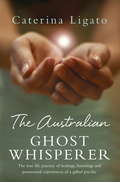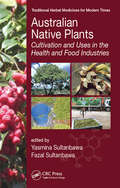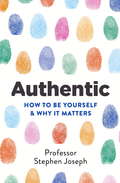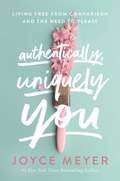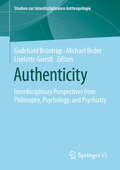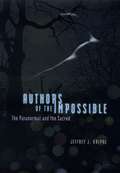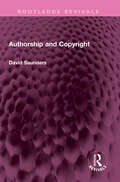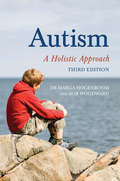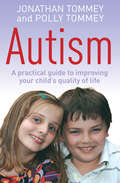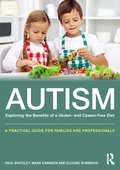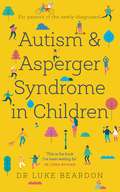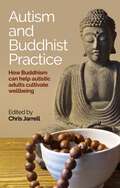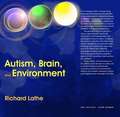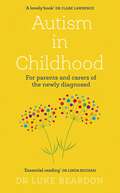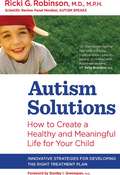- Table View
- List View
The Australian Ghost Whisperer: The true life journey of healings, hauntings and paranormal experiences of a gifted psychic
by Caterina LigatoI opened the door and could just smell the blood and gunshots. I could sense these people who were still in agony because they were caught in the moment of being shot. It was so intense that excruciating pain...'This is the intriguing insight into the world of a Sydney psychic healer. Caterina Ligato first communicated with spirits at the age of three and has since come to accept her gift for dealing with the supernatural and to use her talent to help people in need. Her stories of exorcism, healing sessions and spiritual communication have spread through word-of-mouth, lectures and workshops so that she now receives requests for help from around the world.This is a fascinating and honest story of the astounding personal experiences and relationships between a psychic and the spiritual world.
Australian Native Plants: Cultivation and Uses in the Health and Food Industries (Traditional Herbal Medicines for Modern Times)
by Yasmina Sultanbawa Fazal SultanbawaAustralian Native Plants: Cultivation and Uses in the Health and Food Industries provides a comprehensive overview of native food crops commercially grown in Australia that possess nutritional and health properties largely unknown on a global basis. These native foods have been consumed traditionally, have a unique flavor diversity, offer significant health promoting effects, and contain useful functional properties. Australian native plant foods have also been identified for their promising antioxidant and antimicrobial properties that have considerable commercial potential. This book is divided into three parts: The first part reviews the cultivation and production of many Australian native plants (ANP), including Anise Myrtle, Bush Tomato, Desert Raisin, Davidson’s Plum, Desert Limes, Australian Finger Lime, Kakadu Plum, Lemon Aspen, Lemon Myrtle, Muntries, Native Pepper, Quandong, Riberry, and Wattle Seed. It then examines the food and health applications of ANP and discusses alternative medicines based on aboriginal traditional knowledge and culture, nutritional characteristics, and bioactive compounds in ANP. In addition, it reviews the anti-obesity and anti-inflammatory properties of ANP and discusses food preservation, antimicrobial activity of ANP, and unique flavors from Australian native plants. The third section covers the commercial applications of ANP. It focuses on native Australian plant extracts and cosmetic applications, processing of native plant foods and ingredients, quality changes during packaging, and storage of Australian native herbs. The final few chapters look into the importance of value chains that connect producers and consumers of native plant foods, new market opportunities for Australian indigenous food plants, and the safety of using native foods as ingredients in the health and food sectors.
Australian Native Plants: Cultivation and Uses in the Health and Food Industries (Traditional Herbal Medicines for Modern Times)
by Yasmina Sultanbawa and Fazal SultanbawaAustralian Native Plants: Cultivation and Uses in the Health and Food Industries provides a comprehensive overview of native food crops commercially grown in Australia that possess nutritional and health properties largely unknown on a global basis. These native foods have been consumed traditionally, have a unique flavor diversity, offer significant health promoting effects, and contain useful functional properties. Australian native plant foods have also been identified for their promising antioxidant and antimicrobial properties that have considerable commercial potential. This book is divided into three parts: The first part reviews the cultivation and production of many Australian native plants (ANP), including Anise Myrtle, Bush Tomato, Desert Raisin, Davidson’s Plum, Desert Limes, Australian Finger Lime, Kakadu Plum, Lemon Aspen, Lemon Myrtle, Muntries, Native Pepper, Quandong, Riberry, and Wattle Seed. It then examines the food and health applications of ANP and discusses alternative medicines based on aboriginal traditional knowledge and culture, nutritional characteristics, and bioactive compounds in ANP. In addition, it reviews the anti-obesity and anti-inflammatory properties of ANP and discusses food preservation, antimicrobial activity of ANP, and unique flavors from Australian native plants. The third section covers the commercial applications of ANP. It focuses on native Australian plant extracts and cosmetic applications, processing of native plant foods and ingredients, quality changes during packaging, and storage of Australian native herbs. The final few chapters look into the importance of value chains that connect producers and consumers of native plant foods, new market opportunities for Australian indigenous food plants, and the safety of using native foods as ingredients in the health and food sectors.
Authentic: How to be yourself and why it matters
by Professor Stephen JosephThe hunger for authenticity guides us throughout our lives. People strive for joined-up living, where on the one hand what they say and do reflects what they think and feel, and on the other what they think and feel reflects who they are.Stephen Joseph has pioneered developments in research into authenticity, drawing on the solid science of positive psychology to develop what has become one of the gold-standard tests for assessing authenticity. His and others' findings reveal that when people are in relationships in which they feel accepted, understood and valued, they drop their defences. They naturally begin to examine themselves psychologically, accommodate new information and live more authentically. What's more, the latest studies reveal that it is authenticity that leads to true happiness.In Authentic, Stephen Joseph presents his fresh and inspiring perspective on the psychology of authenticity alongside practical advice and exercises for the reader. Drawing on the wisdom of existential philosophers, the insights and research of psychologists, and case studies from his own and others' clinical experiences, he shows how authenticity is the foundation of human flourishing - as well as how the ideas relate to debates about the importance of happiness.
Authentically, Uniquely You: Living Free from Comparison and the Need to Please
by Joyce MeyerDiscover your unique gifts and dare to be different with #1 New York Times bestselling author and renowned Bible teacher, Joyce Meyer.God has given you gifts so you can fulfill His purpose for your life, but if you're like a lot of people, you may not have recognized your talents yet. Start asking God to show you something special about the way He's made you.To some people, He's given a very tender, compassionate heart, and some He has wired to lead others effectively. Others, He has given a gift of being able to communicate clearly, to teach, to make scientific discoveries, or to write beautiful music. Only you can discover all the dynamic gifts He's placed in you.Become Authentically, Uniquely You because God is never going to help you be anyone but yourself. He loves you just as you are. Let God use you, with all your strengths and weaknesses, and transform you from the inside out to do something powerful beyond your wildest dreams.
Authenticity: Interdisciplinary Perspectives from Philosophy, Psychology, and Psychiatry (Studien zur Interdisziplinären Anthropologie)
by Godehard Brüntrup Michael Reder Liselotte GierstlToday, authenticity is considered an essential part of manifold interpersonal relationships, actions, and agreements. Authenticity’s association with sincerity, honesty, and reliability not only normatively charges the term in the context of social coexistence, but also makes it a demand which we impose on ourselves: The success of our lives is measured decisively by whether we live in harmony with our own convictions, wishes and needs. In philosophy, authenticity has also become the focus of interest, both in the context of the mechanisms of self-knowledge, as well as of personal development.The anthology aims to expand the cooperation across disciplines, in order to develop a comprehensive and profound understanding of authenticity, not by over-simplifying the highly complex subject, but by approaching the underlying concept from different scientific perspectives.
Authors of the Impossible: The Paranormal and the Sacred
by Jeffrey J. KripalMost scholars dismiss research into the paranormal as pseudoscience, a frivolous pursuit for the paranoid or gullible. Even historians of religion, whose work naturally attends to events beyond the realm of empirical science, have shown scant interest in the subject. But the history of psychical phenomena, Jeffrey J. Kripal contends, is an untapped source of insight into the sacred and by tracing that history through the last two centuries of Western thought we can see its potential centrality to the critical study of religion. Kripal grounds his study in the work of four major figures in the history of paranormal research: psychical researcher Frederic Myers; writer and humorist Charles Fort; astronomer, computer scientist, and ufologist Jacques Vallee; and philosopher and sociologist Bertrand Méheust. Through incisive analyses of these thinkers, Kripal ushers the reader into a beguiling world somewhere between fact, fiction, and fraud. The cultural history of telepathy, teleportation, and UFOs; a ghostly love story; the occult dimensions of science fiction; cold war psychic espionage; galactic colonialism; and the intimate relationship between consciousness and culture all come together in Authors of the Impossible, a dazzling and profound look at how the paranormal bridges the sacred and the scientific.
Authors of the Impossible: The Paranormal and the Sacred
by Jeffrey J. KripalMost scholars dismiss research into the paranormal as pseudoscience, a frivolous pursuit for the paranoid or gullible. Even historians of religion, whose work naturally attends to events beyond the realm of empirical science, have shown scant interest in the subject. But the history of psychical phenomena, Jeffrey J. Kripal contends, is an untapped source of insight into the sacred and by tracing that history through the last two centuries of Western thought we can see its potential centrality to the critical study of religion. Kripal grounds his study in the work of four major figures in the history of paranormal research: psychical researcher Frederic Myers; writer and humorist Charles Fort; astronomer, computer scientist, and ufologist Jacques Vallee; and philosopher and sociologist Bertrand Méheust. Through incisive analyses of these thinkers, Kripal ushers the reader into a beguiling world somewhere between fact, fiction, and fraud. The cultural history of telepathy, teleportation, and UFOs; a ghostly love story; the occult dimensions of science fiction; cold war psychic espionage; galactic colonialism; and the intimate relationship between consciousness and culture all come together in Authors of the Impossible, a dazzling and profound look at how the paranormal bridges the sacred and the scientific.
Authors of the Impossible: The Paranormal and the Sacred
by Jeffrey J. KripalMost scholars dismiss research into the paranormal as pseudoscience, a frivolous pursuit for the paranoid or gullible. Even historians of religion, whose work naturally attends to events beyond the realm of empirical science, have shown scant interest in the subject. But the history of psychical phenomena, Jeffrey J. Kripal contends, is an untapped source of insight into the sacred and by tracing that history through the last two centuries of Western thought we can see its potential centrality to the critical study of religion. Kripal grounds his study in the work of four major figures in the history of paranormal research: psychical researcher Frederic Myers; writer and humorist Charles Fort; astronomer, computer scientist, and ufologist Jacques Vallee; and philosopher and sociologist Bertrand Méheust. Through incisive analyses of these thinkers, Kripal ushers the reader into a beguiling world somewhere between fact, fiction, and fraud. The cultural history of telepathy, teleportation, and UFOs; a ghostly love story; the occult dimensions of science fiction; cold war psychic espionage; galactic colonialism; and the intimate relationship between consciousness and culture all come together in Authors of the Impossible, a dazzling and profound look at how the paranormal bridges the sacred and the scientific.
Authors of the Impossible: The Paranormal and the Sacred
by Jeffrey J. KripalMost scholars dismiss research into the paranormal as pseudoscience, a frivolous pursuit for the paranoid or gullible. Even historians of religion, whose work naturally attends to events beyond the realm of empirical science, have shown scant interest in the subject. But the history of psychical phenomena, Jeffrey J. Kripal contends, is an untapped source of insight into the sacred and by tracing that history through the last two centuries of Western thought we can see its potential centrality to the critical study of religion. Kripal grounds his study in the work of four major figures in the history of paranormal research: psychical researcher Frederic Myers; writer and humorist Charles Fort; astronomer, computer scientist, and ufologist Jacques Vallee; and philosopher and sociologist Bertrand Méheust. Through incisive analyses of these thinkers, Kripal ushers the reader into a beguiling world somewhere between fact, fiction, and fraud. The cultural history of telepathy, teleportation, and UFOs; a ghostly love story; the occult dimensions of science fiction; cold war psychic espionage; galactic colonialism; and the intimate relationship between consciousness and culture all come together in Authors of the Impossible, a dazzling and profound look at how the paranormal bridges the sacred and the scientific.
Authors of the Impossible: The Paranormal and the Sacred
by Jeffrey J. KripalMost scholars dismiss research into the paranormal as pseudoscience, a frivolous pursuit for the paranoid or gullible. Even historians of religion, whose work naturally attends to events beyond the realm of empirical science, have shown scant interest in the subject. But the history of psychical phenomena, Jeffrey J. Kripal contends, is an untapped source of insight into the sacred and by tracing that history through the last two centuries of Western thought we can see its potential centrality to the critical study of religion. Kripal grounds his study in the work of four major figures in the history of paranormal research: psychical researcher Frederic Myers; writer and humorist Charles Fort; astronomer, computer scientist, and ufologist Jacques Vallee; and philosopher and sociologist Bertrand Méheust. Through incisive analyses of these thinkers, Kripal ushers the reader into a beguiling world somewhere between fact, fiction, and fraud. The cultural history of telepathy, teleportation, and UFOs; a ghostly love story; the occult dimensions of science fiction; cold war psychic espionage; galactic colonialism; and the intimate relationship between consciousness and culture all come together in Authors of the Impossible, a dazzling and profound look at how the paranormal bridges the sacred and the scientific.
Authors of the Impossible: The Paranormal and the Sacred
by Jeffrey J. KripalMost scholars dismiss research into the paranormal as pseudoscience, a frivolous pursuit for the paranoid or gullible. Even historians of religion, whose work naturally attends to events beyond the realm of empirical science, have shown scant interest in the subject. But the history of psychical phenomena, Jeffrey J. Kripal contends, is an untapped source of insight into the sacred and by tracing that history through the last two centuries of Western thought we can see its potential centrality to the critical study of religion. Kripal grounds his study in the work of four major figures in the history of paranormal research: psychical researcher Frederic Myers; writer and humorist Charles Fort; astronomer, computer scientist, and ufologist Jacques Vallee; and philosopher and sociologist Bertrand Méheust. Through incisive analyses of these thinkers, Kripal ushers the reader into a beguiling world somewhere between fact, fiction, and fraud. The cultural history of telepathy, teleportation, and UFOs; a ghostly love story; the occult dimensions of science fiction; cold war psychic espionage; galactic colonialism; and the intimate relationship between consciousness and culture all come together in Authors of the Impossible, a dazzling and profound look at how the paranormal bridges the sacred and the scientific.
Authorship and Copyright (Routledge Revivals)
by David SaundersFirst published in 1992, Authorship and Copyright traces the history of constructions of authorship as a legal reality. It offers an alternative to the two mainstream interpretations that have traditionally been assigned to authorship: the Romantic dialectical ‘birth of the author’ or the language-based post-structuralist ‘death of the author.’ Saunders examines the shortcomings of both schemes by arguing that they impose an arbitrary philosophical direction on the history of authorship and the law of copyright. Saunders addresses the issues relating to copyright and the construction of authorship as a legal status. Combining information and polemic, the author explores such matters as the historical and theoretical relations of copyright and the droit moral, the aestheticization of the law and the juridification of aesthetics, and the argument that authorship as a legal reality is a historically contingent and variable arrangement that cannot be separated from its cultural and juridical context. This book will be of interest to students of law, literature and philosophy.
Authorship and Copyright (Routledge Revivals)
by David SaundersFirst published in 1992, Authorship and Copyright traces the history of constructions of authorship as a legal reality. It offers an alternative to the two mainstream interpretations that have traditionally been assigned to authorship: the Romantic dialectical ‘birth of the author’ or the language-based post-structuralist ‘death of the author.’ Saunders examines the shortcomings of both schemes by arguing that they impose an arbitrary philosophical direction on the history of authorship and the law of copyright. Saunders addresses the issues relating to copyright and the construction of authorship as a legal status. Combining information and polemic, the author explores such matters as the historical and theoretical relations of copyright and the droit moral, the aestheticization of the law and the juridification of aesthetics, and the argument that authorship as a legal reality is a historically contingent and variable arrangement that cannot be separated from its cultural and juridical context. This book will be of interest to students of law, literature and philosophy.
Autism: A Holistic Approach
by Marga HogenboomEducating and caring for an autistic child is a severely difficult task, too often associated with frustration and disappointment. As a result, the inner development of children with autism is at times considered to be beyond the reach of parents and carers. This book challenges that assumption, exploring case studies where therapy based on a holistic approach has resulted in marked improvements in the autistic child's behaviour and social integration. With an extended holistic programme, autistic children discover inner self-awareness and self-recognition, leading to first steps in relationships and social skills. The authors describe in detail their own practical experiences, as well as the findings of other experts in the field. This new third edition covers recent developments in diagnostic methods and approaches to treatment, including new case studies and a new chapter looking at the sensory aspect of autism and Sensory Integration Therapy. Well-researched and movingly written, this book has an essential, positive message for all those involved in the care and education of autistic children.
Autism: A practical guide to improving your child's quality of life
by Polly Tommey Jon TommeyThis book shares the authors' personal experience of bringing up their autistic son who at age 13 is now described as high functioning (from an early diagnosis of severe autism). It also draws on the latest research and expert opinion from around the world. The book will give parents and carers the confidence and knowledge they need to tackle the problems and issues they face. There is much that can be done to improve the quality of an autistic child's life. The book shares Jon's experience with some of the children he has treated who have done so well that they can be considered recovered. The book includes: advice for the first year of a child's life; the facts and risks of vaccination; diagnosis and the impact on a family; a look at the therapies available and why different ones will suit different children; the importance of diet and how to alleviate the debilitating gut problems experienced by most children; advice on education and schooling; how to cope as a family and a couple; dealing with difficult issues such as puberty; and thinking about the longterm future for your child. Strong resources section included.
Autism: A practical guide for families and professionals
by Paul Whiteley Mark Earnden Elouise RobinsonAutism represents one of the biggest health challenges facing children today. Whilst experts around the globe strive to unravel and truly understand how autism develops and presents itself, relatively little is still known about the condition. Meanwhile, strong evidence has emerged that the diet in children on the autistic spectrum can have a significant role to play in the management of their symptoms. A growing body of research reveals that some challenging characteristics present in autism may be positively affected by the introduction of a gluten- and casein-free (GFCF) diet. Autism: Exploring the benefits of a gluten and casein free diet offers an easy-to-read alternative to sifting through the science. Written by experts in autism research, food, nutrition and dietetics, the book cuts through the science-speak to offer readers a no-nonsense overview of diet and autism together with a range of useful recipes and handy hints for making mealtimes fun for children with autism and related conditions.
Autism: A practical guide for families and professionals
by Paul Whiteley Mark Earnden Elouise RobinsonAutism represents one of the biggest health challenges facing children today. Whilst experts around the globe strive to unravel and truly understand how autism develops and presents itself, relatively little is still known about the condition. Meanwhile, strong evidence has emerged that the diet in children on the autistic spectrum can have a significant role to play in the management of their symptoms. A growing body of research reveals that some challenging characteristics present in autism may be positively affected by the introduction of a gluten- and casein-free (GFCF) diet. Autism: Exploring the benefits of a gluten and casein free diet offers an easy-to-read alternative to sifting through the science. Written by experts in autism research, food, nutrition and dietetics, the book cuts through the science-speak to offer readers a no-nonsense overview of diet and autism together with a range of useful recipes and handy hints for making mealtimes fun for children with autism and related conditions.
Autism and Asperger Syndrome in Childhood: For parents and carers of the newly diagnosed
by Luke BeardonAn easy-to-read introduction to autism for parents of a newly diagnosed child to know where to start. This book is specifically for those who know little or nothing about autism and Asperger syndrome until their child is diagnosed. Written by a renowned expert in the field, Autism and Asperger Syndrome in Children gently but honestly explores the issues of being a parent to a child with autism. It analyses what autism actually is, as opposed to the myths and misconceptions about it, and what it might mean to the child, parent, and wider family. Topics include:Diagnosis?Autism theory, myths and alternative perspectivesSensory issuesConversations with your child - the 'autistic voice'How to handle your child's anxietyHappy autistic childrenEducationThe strengths of autismFAQsDr Luke Beardon says, 'Welcome to the world of autism - and an intriguing, beguiling, frustrating, and remarkable world it is! Irrespective of what you might have been told, or what preconceptions anyone might have, I hope this book will help you understand your child's unique value and importance in the world.'
Autism and Buddhist Practice: How Buddhism Can Help Autistic Adults Cultivate Wellbeing
by Chris JarrellThis series of reflective accounts explores the benefits that Buddhist practice can bring for autistic individuals, and outlines how Dharma teachers, centre directors and meditation group leaders can help ensure sessions are truly autism sensitive.Including a wide range of international contributors discussing aspects of their autistic experience and the impact of Buddhism on their lives, this is a thought-provoking and often moving portrayal of the intersect between the lived experience of autistic people and spiritual practice. The deeply personal accounts of the positive impact Buddhist practices have had on relationships, social interactions, sensory overload, mental health and wellbeing, provide an opportunity to find out more about both Buddhism and the support that it can offer to the autistic community through, for example, personal practice, parenting and special educational provision.
Autism and Buddhist Practice: How Buddhism Can Help Autistic Adults Cultivate Wellbeing
by Chris JarrellThis series of reflective accounts explores the benefits that Buddhist practice can bring for autistic individuals, and outlines how Dharma teachers, centre directors and meditation group leaders can help ensure sessions are truly autism sensitive.Including a wide range of international contributors discussing aspects of their autistic experience and the impact of Buddhism on their lives, this is a thought-provoking and often moving portrayal of the intersect between the lived experience of autistic people and spiritual practice. The deeply personal accounts of the positive impact Buddhist practices have had on relationships, social interactions, sensory overload, mental health and wellbeing, provide an opportunity to find out more about both Buddhism and the support that it can offer to the autistic community through, for example, personal practice, parenting and special educational provision.
Autism, Brain, and Environment
by Richard LatheThe increasing number of people being diagnosed with autism spectrum disorders (ASDs) cannot simply be explained by changes in diagnostic criteria or greater awareness of the condition. In this controversial new book, Richard Lathe contends that the recent rise in cases of ASDs is a result of increased exposure to environmental toxicity combined with genetic predisposition. Autism, Brain, and Environment proposes that autism is a disorder of the limbic brain, which is damaged by toxic heavy metals present in the environment. Lathe argues that most ASD children have additional physiological problems and that these, far from being separate from the psychiatric aspects of ASD, can produce and exacerbate the condition. This important and groundbreaking text provides a closely-argued scientific case for the involvement of both environmental and physiological factors in autism. Lathe's argument will also have a direct impact on treatment strategies and options. It will be of great interest to the scientific community, professionals, researchers, political and environmental lobbyists, teachers, psychologists, and parents and people with ASDs.
Autism, Brain, and Environment (PDF)
by Richard LatheThe increasing number of people being diagnosed with autism spectrum disorders (ASDs) cannot simply be explained by changes in diagnostic criteria or greater awareness of the condition. In this controversial new book, Richard Lathe contends that the recent rise in cases of ASDs is a result of increased exposure to environmental toxicity combined with genetic predisposition. Autism, Brain, and Environment proposes that autism is a disorder of the limbic brain, which is damaged by toxic heavy metals present in the environment. Lathe argues that most ASD children have additional physiological problems and that these, far from being separate from the psychiatric aspects of ASD, can produce and exacerbate the condition. This important and groundbreaking text provides a closely-argued scientific case for the involvement of both environmental and physiological factors in autism. Lathe's argument will also have a direct impact on treatment strategies and options. It will be of great interest to the scientific community, professionals, researchers, political and environmental lobbyists, teachers, psychologists, and parents and people with ASDs.
Autism in Childhood: For parents and carers of the newly diagnosed
by Luke Beardon"If every parent receiving a diagnosis of autism for their child could read this book, it would avoid so much misunderstanding and unhappiness." - Dr Clare LawrenceA diagnosis - or a suspected diagnosis - of autism in a child can be overwhelming for a parent, especially if you know nothing, or very little, about either of them.Dr Luke Beardon is a well-known expert in the field, and this book is an accessible, easy-to-read introduction for those encountering autism for the first time. Gently and honestly, it guides you through the issues you might encounter, busting the myths around autism, and explaining what the diagnosis means for your child, for you, and for your wider family. It looks at sensory profiles, helps you handle your child's anxiety, tackles education, and answers a variety of frequently asked questions.Other topics covered by this sensitive and empowering book include how to have conversations with your child (the 'autistic voice'), how to manage your child's education and - importantly - the undeniable strengths of autism.As an introduction to - and a celebration of - the intriguing, beguiling, frustrating and remarkable world of autism, this book will help you understand your child's unique value and importance in the world.
Autism Solutions: How To Create A Healthy And Meaningful Life For Your Child (Harlequin Non-fiction Ser.)
by Ricki G. RobinsonHope - and Help - for Your Child
